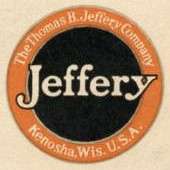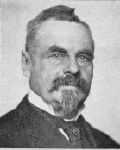Thomas B. Jeffery Company

The Thomas B. Jeffery Company was an American automobile manufacturer in Kenosha, Wisconsin from 1902 until 1916. The company manufactured the Rambler and Jeffery brand motorcars. It was preceded by the Gormully & Jeffery Manufacturing Company, a bicycle manufacturer. It was the parent company to Nash Motors, thus one of the parent companies of American Motors and Chrysler.
Thomas B. Jeffery


Thomas B. Jeffery was an inventor and an industrialist. He was one of America's first entrepreneurs interested in automobiles in the late 19th century. In 1897, he built his first prototype motorcar. Thomas B. Jeffery was serious enough about automobiles to sell his stake in Gormully & Jeffery to the American Bicycle Company to finance the new car company.
Business


Charles T. Jeffery's (Thomas' son) experimental prototypes of 1901 (Models A & B) used at least two radical innovations – steering wheels and front-mounted engines. By the time Charles was ready for production in 1902, his father had talked him out of these wild dreams and convinced him to stick with tillers and engines under the seat.
From 1902 until 1908, Jeffery moved steadily to bigger, more reliable models starting with the 1902 Model C. Jeffery cars were built on assembly lines (the second manufacturer to adopt them -- Ransom E. Olds was first), and in 1903 Jeffery sold 1,350 Ramblers. By 1905, Jeffery more than doubled this number. One reason may have been because Charles went back to the steering wheel before 1904. In 1907, Jeffery was building a large variety of different body styles and sizes. Among them was a five-passenger, US$2,500 Rambler weighing 2,600 pounds (1179 kg) and powered by a 40-horsepower (30 kW) engine.
In April, 1910, Thomas B. Jeffery, died in Pompeii, Italy and in June of that year the business was incorporated under the name of the Thomas B. Jeffery Company, with Charles T. Jeffery as the president and general manager, H. W. Jeffery, vice president and treasurer.
In 1915, Charles T. Jeffery, changed the automotive branding from Rambler to Jeffery to honor the founder, his father, Thomas B. Jeffery.
As of 1916, G. H. Eddy replaced H.W. Jeffery as the treasurer so H.W. Jeffery could focus on the position of vice president. G. W. Greiner was the secretary, L. H. Bill the general manager, J. W. DeCou the factory manager, and Al Recke was the sales manager.
Charles T. Jeffery survived the sinking of the RMS Lusitania (a British luxury liner torpedoed by the Germans in World War I) in 1915 and decided to spend the rest of his life in a more enjoyable manner. Charles W. Nash resigned from General Motors, saw an opportunity and bought the Thomas B. Jeffery Company in August 1916.
The Factory



Jeffery, with the money from his sale of Gormully & Jeffery, bought the old Sterling Bicycle Company's factory in Kenosha, Wisconsin. The original factory building was only 600 x 100 feet (183 x 30 m) in size. However, by 1916, the company's buildings expanded over 20 acres (8 ha) under roof and the facilities had grown to over 100 acres (40 ha) including a test track.
Jeffery Quad
The Jeffery Quad, also known as the Nash Quad or Quad is a four-wheel drive truck that was developed and built in Kenosha from 1913, and after 1916, by Nash Motors, as well as under license by other truck makers.. The Quad introduced numerous engineering innovations. Its design and durability proved effective in traversing the muddy, rough, and unpaved roads of the times. The Quad also became one of the effective work vehicles in World War I.[1] The Quad was also one of the first successful four-wheel drive vehicles ever to be made, and its production continued unchanged through 1928, or 15 years, with a total of 41,674 units made.[2]
Timeline
1897 – Jeffery builds a rear-engine Rambler prototype using the Rambler name previously used on a highly successful line of bicycles made by Gormully & Jeffery.
1899 – Positive reviews at the 1899 Chicago International Exhibition & Tournament and the first National Automobile Show in New York City prompt the Jefferys to enter the automobile business.
1900 (Dec 6) – Thomas B. Jeffery finalizes a US$65,000 deal to buy the Kenosha, Wisconsin, factory of the defunct Sterling Bicycle with money from the sale of his interest in Gormully & Jeffery.[3]
1901 – Two more prototypes, Models A and B, are made.
1902 – First production Ramblers – the US$750 Model C open runabout and the $850 Model D (the same car with a folding top). Both are powered by an 8-horsepower (6 kW; 8 PS), 98-cubic-inch (1.6 L) one-cylinder engine mounted beneath the seat, and are steered by a right-side tiller. First-year production totals 1,500 units making Jeffery the second-largest car maker behind Oldsmobile.[3]
1910 (Mar 21) – Thomas B. Jeffery dies while on vacation in Italy.
1910 (Jun 10) – Charles incorporates the firm as a $3 million (US$76,317,857 in 2016 dollars[4]) public stock company.[3]
1914 – The Rambler name is replaced with the Jeffery moniker in honor of the founder.
1916 (Aug) – Charles Jeffery sells the company to former General Motors Corp. President Charles W. Nash.
1917 – Charles Nash renames the Jeffery Motor Company, Nash Motors after himself.
Notes
- ↑ "Charles Thomas Jeffery". The Lusitania Resource. Retrieved 6 December 2014.
- ↑ Redgap, Curtis; Watson, Bill (2010). "The Jefferys Quad and Nash Quad — 4x4 Ancestor to the Willys Jeep". Allpar. Retrieved 6 December 2014.
- 1 2 3 Binder, Al (1 December 2003). "Rear View Mirror: 103 Years Ago". Ward's Auto World. Retrieved 16 June 2011.
- ↑ Federal Reserve Bank of Minneapolis Community Development Project. "Consumer Price Index (estimate) 1800–". Federal Reserve Bank of Minneapolis. Retrieved October 21, 2016.
External links
| Wikimedia Commons has media related to Thomas B. Jeffery Company. |
- 1916 advertisement for Jeffery Quad, p. 481
- Schematic drawing of Jeffery Quad chassis
- Data sheet for Armored Car #1 (U.S. Army), build on Jeffery Quad chassis at Rock Island Arsenal, 1916
- Photo of armored rear-drive Jeffery truck (not a Quad)